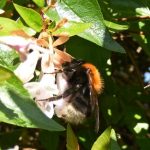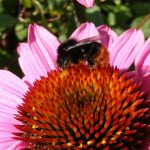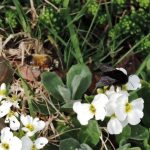Trevor Smith ran a bee identification day at Woolley Firs near Maidenhead, the Environmental Education Centre of BBOWT, the local Wildlife Trust, on Saturday 2 June. The event was run jointly for members of BBOWT and Reading and District Natural History Society. In the morning, Trevor gave a series of Powerpoint presentations, outlining the earliest origins of bees, the different families of bees, their lifestyles and their environmental requirements. He talked about social and solitary bees, the differences between male and female bees, cuckoo bees and much more. After lunch, the group went outside into the warm sunshine to look for bees. In front of the building, comfrey and catmint flowers were magnets for bumblebees, These included the Common Carder Bee Bombus pascuorum, the Early Bumblebee Bombus pratorum and the Tree Bumblebee Bombus hypnorum, which was first recorded in this country in 2001 and has since spread rapidly. A large specimen with long antennae, a long abdomen and no pollen baskets was identified as a male Garden Bumblebee Bombus hortorum. A deutzia bush which was covered in white bell-shaped flowers had also attracted large numbers of bees including a queen Red-tailed Bumblebee Bombus lapidarius, a queen Buff-tailed Bumblebee Bombus terrestris, a large Southern Cuckoo Bumblebee Bombus vestalis and a few solitary bees. Bramble blossom, Green Alkanet, Cotoneaster and Philadephus were also good places to find bees. An all-black specimen was identified as a Hairy-footed Flower Bee Anthophora plumipes. The group then walked to the pond, which was inhabited by many tadpoles and a few newts. Blue male and yellow female Broad-bodied Chasers were active above the pond and an Emperor Dragonfly patrolled around. Honey Bees were drinking water at the shallow edges of the pond. Nearby was a bee hotel. In his morning talk, Trevor had warned about these structures. If normally solitary species are encouraged to live in bigger groups, there is a danger that this will increase the spread of pathogens and parasites. Any parts which cannot be cleaned should be removed. The final part of the walk was back through the meadow, where Common Bird’s-foot-trefoil was in flower. Common Blue butterflies were seen here, together with a single Meadow Brown.
Pictures by Rob Stallard



